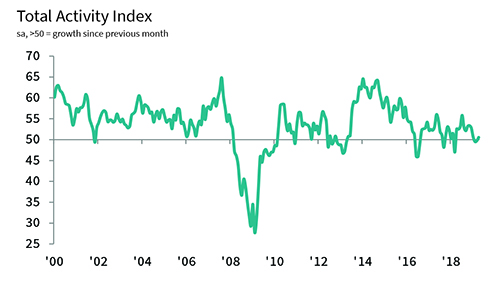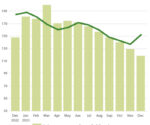House building helps UK construction sector return to growth in April

April data pointed to a marginal expansion of UK construction output, driven by the fastest rise in house building so far in 2019. Commercial work and civil engineering activity continued to decline, but at slower rates than in March.
The forward-looking survey indicators nonetheless remainedsubdued in April, with new orders falling for the first time sinceMay 2018 and business optimism easing to its lowest since last October. Concerns about the demand outlook resulted inmore cautious staff hiring strategies in April, as highlighted by the first fall in workforce numbers since July 2016.
At 50.5 in April, up from 49.7 in March, the headline seasonally adjusted IHS Markit/CIPS UK Construction Total Activity Index posted above the neutral 50.0 threshold for the first time since January. The latest reading signalled a modestexpansion of overall construction output, which contrasted with the declines seen in each of the previous two months.
House building was by far the strongest performing area of construction work in April. Latest data revealed a solid expansion of residential work, with the rate of growth reaching its highest since December 2018. Survey respondentscommented on resilient demand conditions and a strong flowof new buyers.
Commercial work was the weakest area of constructionoutput in April, which continued the trend seen during the first quarter of 2019. A number of firms linked lower commercialconstruction to Brexit-related uncertainty and delays with client spending decisions. Civil engineering activity also decreased in April, although the rate of contraction was onlymarginal. Some firms commented on a lack of new work toreplace completed infrastructure projects.
Construction companies indicated a modest decline in total new orders during April. The fall in new work was the fastest recorded since March 2018. Anecdotal evidence suggested thatpolitical uncertainty, softer UK economic growth projectionsand subdued demand for new commercial projects had all contributed to fewer tender opportunities.
Employment numbers fell slightly during April, which ended more than two-and-a-half years of sustained expansion. Survey respondents noted that lower business optimism andfalling sales volumes had held back staff hiring.
Meanwhile, supplier performance deteriorated sharply in April, despite subdued demand for construction materials. The latest lengthening of vendor lead times was the greatest recorded since February 2015. Construction companies widely commented on low stocks and capacity constraints among vendors.
Stretched supply chains and rising raw material prices contributed to higher purchasing costs across the constructionsector. The rate of input price inflation accelerated for thethird month running and was the fastest since November 2018. Adding to pressures on operating expenses, latest data also pointed to a robust and accelerated increase in rates charged by sub-contractors in April.
Tim Moore, Associate Director at IHS Markit, which compiles the survey:“A return to growth would normally be considered a positive month for the UK construction sector, but the weakness outside of house building gives more than a little pause for thought. Commercial activity and civil engineering both remained on a downward path in April as political uncertainty led to delays with spending decisions.
“Residential work retained its position as the sole driver of growth across the three main segments of construction activity. Survey respondents once again noted that residential projects were buoyed by strongdemand for new homes, low mortgages rates and first-time buyer incentives.
“On the supply side, sub-contractor availability worsened and construction firms continued to reportlow stocks among suppliers in April. Latest data revealed the greatest lengthening of lead times forconstruction inputs since February 2015, reflectingongoing capacity pressures across the supply chain.
“The forward-looking survey indicators remainsubdued, with the UK construction sector recording a drop in business optimism during April and the largest fall in new work for over one year. A lack of new workhas started to impact on staff recruitment, as signalled by a reduction in payroll numbers for the first timesince July 2016. This provides another signal thatconstruction firms are bracing for an extended period of soft demand ahead.”











